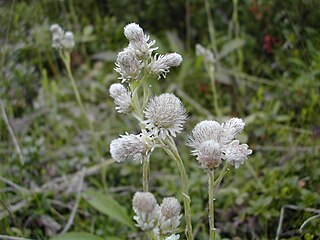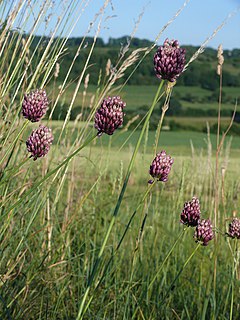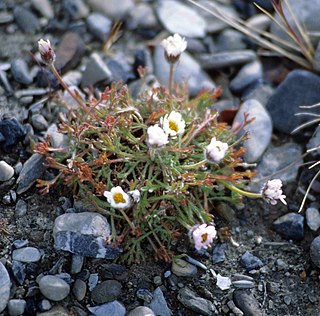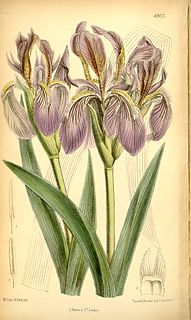
Antennaria alpina is a European and North American species of plant in the family Asteraceae. Antennaria alpina is native to mountainous and subarctic regions of Scandinavia, Greenland, Alaska, and the Canadian Arctic, extending south at high altitudes in mountains in the Rocky Mountains south to Montana and Wyoming.

Cornus canadensis is a species of flowering plant in the dogwood family Cornaceae, native to eastern Asia and North America. Common names include Canadian dwarf cornel, Canadian bunchberry, quatre-temps, crackerberry, and creeping dogwood. Unlike its relatives, which are for the most part substantial trees and shrubs, C. canadensis is a creeping, rhizomatous perennial growing to about 20 centimetres tall.

Symphyotrichum lateriflorum is a species of flowering plant in the aster family (Asteraceae). Commonly known as calico aster, starved aster, and white woodland aster, it is native to eastern and central North America. It is a perennial and herbaceous plant that may reach heights up to 120 centimeters and widths up to 30 cm (1 ft).

Salix glauca is a species of flowering plant in the willow family known by the common names gray willow, grayleaf willow, white willow, and glaucous willow. It is native to North America, where it occurs throughout much of Alaska, northern and western Canada, and the contiguous United States south through the Rocky Mountains to northern New Mexico. It can also be found in Greenland, northwestern Europe, and Siberia.
Luzula wahlenbergii, commonly known as Wahlenberg's woodrush or reindeer wood-rush, is a perennial species of plant in the genus Luzula of the (rush) family Juncaceae.
Calamagrostis lapponica, the Lappland reedgrass, is a grass species native to colder parts of the Northern Hemisphere. It has been reported from Scandinavia, Russia, Greenland, Alaska, and every Canadian province and territory except the Maritime Provinces.

Claytonia ogilviensis, common name Ogilvie Mountains spring beauty, is a plant endemic to the Ogilvie Mountains and the Dawson Range in the Yukon Territory of Canada. These mountains extend into Alaska, and one of the known populations is less than 1 km from the border, so it would not be surprising if the plant were to be found in Alaska as well.
Arabidopsis arenicola, the Arctic rock-cress, is a plant species native to the northeastern part of North America. It has been reported from Greenland, Labrador, Nunavut, Northwest Territories, Québec, Ontario, Manitoba, and Saskatchewan. It grows on sandy or gravely beaches or stream banks at elevations below 1,500 metres (4,900 ft).

Allium rotundum, common name round-headed leek or purple-flowered garlic, is a Eurasian and North African species of wild onion. Its native range extends from Spain and Morocco to Iran and European Russia. It is sparingly naturalized in parts of the United States. The species grows in disturbed habitats such as roadsides, cultivated fields, etc.

Allium crenulatum, common name Olympic onion, is a plant species native to Oregon, Washington, and British Columbia. It grows in the Cascades, the Coast Ranges, the Olympic Mountains, the Wenatchee Mountains, and the mountains on Vancouver Island. There is one report from Alabama, but this needs verification. The species grows on talus slopes and in alpine tundra at elevations of 600–2500 m.

Iris ruthenica, sometimes called ever blooming iris, Russian iris, pilgrim iris and Hungarian iris, is a species in the genus Iris- subgenus Limniris. It is a rhizomatous perennial, with a wide distribution, ranging from eastern Europe to Central Asia. It has grass-like leaves, thick stem and violet or bluish lavender flowers which are marked with violet veining.

Iris halophila is a species in the genus Iris, it is also in the subgenus Limniris and in series Spuriae. It is a rhizomatous perennial plant, with yellow, white or violet flowers. It is cultivated as an ornamental plant in temperate regions. It comes from a wide range from eastern Europe to China in Asia. It was known for a long while as a subspecies of Iris spuria, before being treated as a separate species in its own right.
Iris falcifolia is a plant species in the genus Iris, it is also in the subgenus Iris and in the section Hexapogon. It is a rhizomatous perennial, from Uzbekistan, Kazakhstan, Afghanistan, Iran and Pakistan. It is a small plant, with sickle-shaped greyish-green leaves, lilac-violet flowers and darker veining, and a white or yellow beard. It is cultivated as an ornamental plant in dry, temperate regions.
Iris darwasica is a plant species in the genus Iris, it is also in the subgenus Iris and in the section Regelia. It is a rhizomatous perennial, from Tajikistan and northern Afghanistan. It has long and thin glaucous to grey-green leaves, slender stem and greenish cream or greenish yellow, to dark purple or lilac flowers.

Arctanthemum integrifolium, the entire-leaved daisy, is a subarctic species of plant in the sunflower family. It grows in Alaska, northern Canada, Peary Land in northern Greenland, and the East Chukotka region of eastern Russia.

Iris scariosa is a plant species in the genus Iris, it is also in the subgenus Iris. It is a rhizomatous perennial, from the mountainsides of Russia, Kazakhstan, Mongolia and China. It has sword-like, or sickle shaped, blue green or grey-green leaves, a short flowering stem, 3 or 4 membranous or semi-transparent flower bud leaves, 2 violet, reddish violet, lilac, blue-purple, or blue flowers in late spring, with yellow or white beards. It is cultivated as an ornamental plant in temperate regions. It was merged with another similar iris in the region, and Iris glaucescens became a synonym of Iris scariosa, before being divided into two separate species again. Although some sources still call it the main species, despite a slight colour difference.

Leucospermum oleifolium is an erect shrub of about 1 m (3.3 ft) high and 1½ m (5 ft) across that is assigned to the family Proteaceae. It has spreading branches, densely set with initially felty, entire, oval, olive-colored leaves of about 3½ cm long and 1½ cm (0.6 in) wide, with a bony tip that sometimes has two to five blunt teeth, with a blunt base and conspicuous veins. The flowers and their long thread-like styles are initially sulfur yellow, but soon become orange and finally turn brilliant crimson. The flower heads are about 4 cm (1.6 in) in diameter, crowded at the tip of the branches with a maximum of five that start flowering in turn. This provides for a colour spectacle from August till December. It is called by various names in South Africa such as Overberg pincushion, flame pincushion, mix pincushion and tuft pincushion. It naturally occurs in fynbos in the Western Cape province of South Africa.

Leucospermum pedunculatum is an evergreen, low shrub of 15–30 cm (5.9–11.8 in) high spreading from a single stern upright stem, from the family Proteaceae. The powdered or hairless line-shaped to somewhat sickle-shaped leaves are 3–6 cm (1.2–2.4 in) long and 2–5 mm (0.08–0.20 in) wide. The stalked, individually set flower heads are globe-shaped, 2½−3 cm in diameter consist of initially white to pale cream flowers that eventually turn carmine. From the center of the flowers emerge straight styles that jointly give the impression of a pincushion. It is called white-trailing pincushion in English. It flowers from August to January, peaking in September. It is an endemic species that is restricted to a narrow strip on the south coast of the Western Cape province of South Africa.

Carex bicolor, the bicoloured sedge, is a species of sedge native to North America, Northern Europe and Northern Asia. The International Union for Conservation of Nature has assessed the plant's conservation status as being of least concern because it has a widespread distribution and faces no particular threats.

Ranunculus arcticus, the birdfoot buttercup, is a species of buttercup in the family Ranunculaceae. It has a circumpolar distribution in Northern Europe, Northern Asia and North America.














